Speelkaartenfabriek Nederland Maritime Deck
Dutch Maritime pack designed by J.Verhoeven and printed by Speelkaartenfabriek Nederland c1938
A beautifully designed Dutch Maritime pack designed by J.Verhoeven dealing with shipping through time, with marine figures and statues on the court cards and historic ships on the aces. Printed by Speelkaartenfabriek Nederland c1938. The four aces have different scenes at each end as follows:
Ace of Spades: Oorlogschip c1642. A warship of the Dutch Navy with 50 gunports. Reverse: Kruiser De Ruyter 1936. She was a Light Cruiser of 6,500 tons of the Dutch Navy. She was in service until 1942 when she was sunk by a torpedo at the Battle of the Java Sea. Her ship’s bell was recovered and is displayed in the Kloosterkirk in The Hague. Ace of Diamonds: Walvischvaarder c1700. A whaling ship. Since 1982 the International Whaling Commission has placed a moratorium on whaling. Japan, Iceland, Norway and Russia oppose this but Japan, Iceland and Norway are still catching whales. Reverse: Stoomtrawler 1938. A steam trawler. Ace of Clubs: Beurtman c1700. A coastal barge. Reverse: Rijnaak 1935. A high capacity barge. At the end of their useful lives a lot of these barges were converted into accommodation. In fact you can still stay in a barge hotel on the river Amstel in Amsterdam today. Ace of Hearts: Koopvaarder c1600. This was a Dutch armed merchantman, usually 3-masted, used by the Dutch East India Company. It has 10 gunports. Reverse: New Amsterdam 1938. This liner of 36.000 tons was in service until 1973 and was nicknamed “The Darling of the Dutch”. She was one of the very few Trans Atlantic liners still operating after jet aircraft took over most of the traffic.
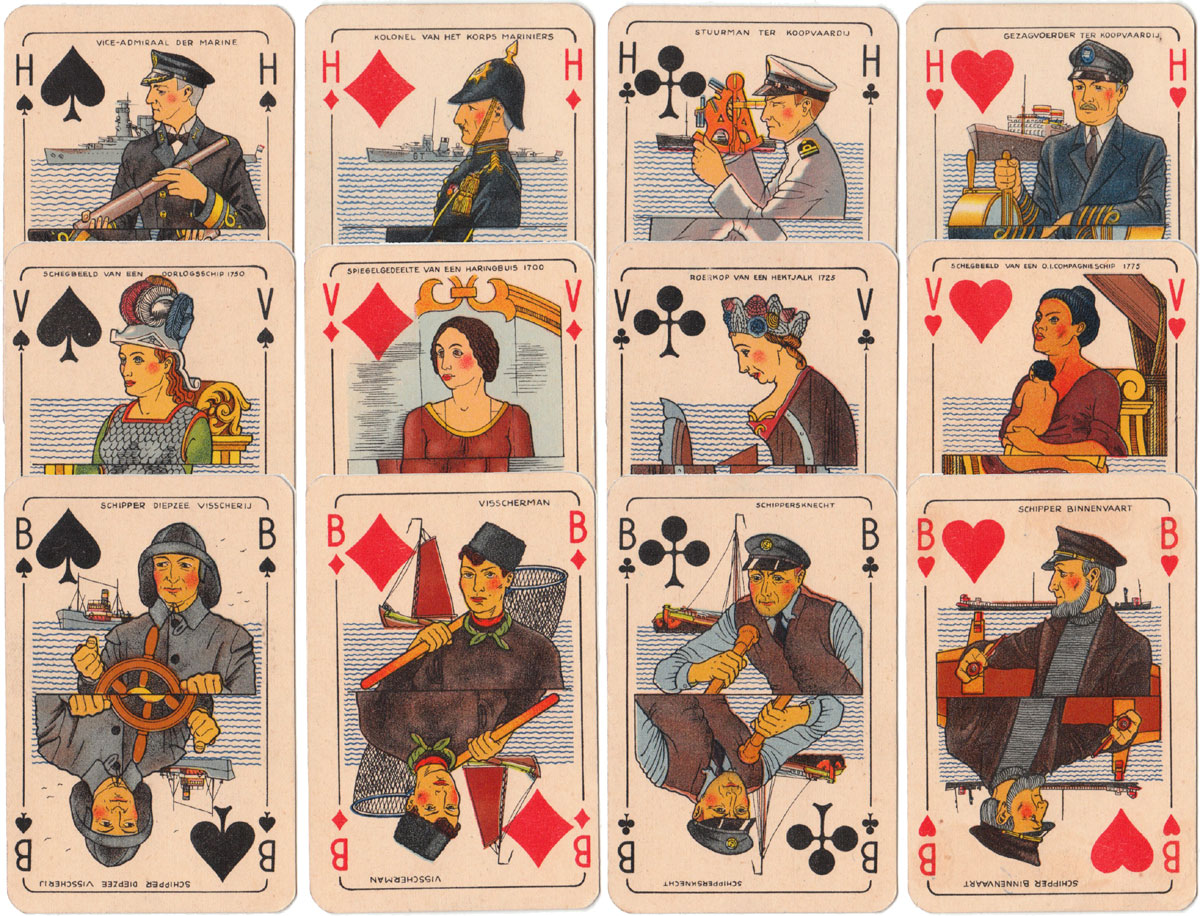
Above: Dutch Maritime pack designed by J.Verhoeven and printed by Speelkaartenfabriek Nederland c1938. Images courtesy Rex Pitts.
King of Spades: Vice Admiral of the Navy
Queen of Spades: Figurehead of a Warship 1750
Jack of Spades: Skipper of a deep sea fishing vessel
King of Diamonds: A Colonel in the Marine Corps
Queen of Diamonds: The mirror on board a Herring Buss, which was a type of fishing vessel which often carried whole families out on fishing trips. The herring were caught in drift nets and immediately gutted, salted and put into barrels on board
Jack of Diamonds: A fisherman. As he is carrying a landing net he may well have been using a line to catch his fish.
King of Clubs: The First Mate on a Merchant Ship
Queen of Clubs: This is a small type of figurehead, usually just a head like a bust, mounted at the rear of the vessel at the rudder station. This one is on an old fashioned kind of barge which literally translates as fence barge.
Jack of Clubs: A Bargeman’s mate
King of Hearts: Merchant Marine Captain
Queen of Hearts: Figurehead of an East India Company ship 1775. The Dutch East India Company was founded in 1602 and lasted until 1799. It was originally granted a charter by the Dutch government to exploit the spice trade. It became huge with a fleet approaching 5,000 ships and employing a million Europeans in the course of its trading.
Jack of Hearts: A Skipper of an inland vessel
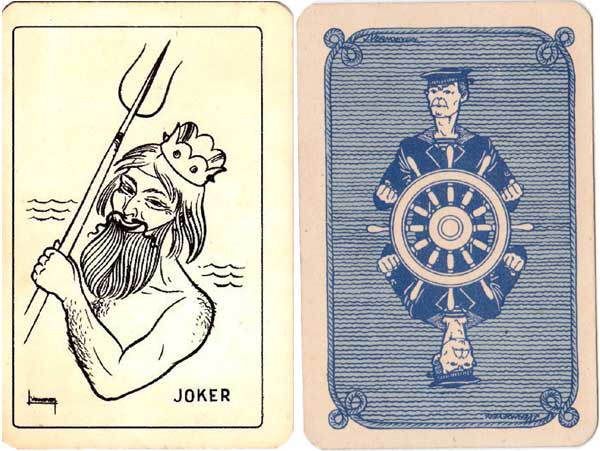
Above: Neptune is the Joker.
By Rex Pitts (1940-2021)
United Kingdom • Member since January 30, 2009
Rex's main interest was in card games, because, he said, they were cheap and easy to get hold of in his early days of collecting. He is well known for his extensive knowledge of Pepys games and his book is on the bookshelves of many.
His other interest was non-standard playing cards. He also had collections of sheet music, music CDs, models of London buses, London Transport timetables and maps and other objects that intrigued him.
Rex had a chequered career at school. He was expelled twice, on one occasion for smoking! Despite this he trained as a radio engineer and worked for the BBC in the World Service.
Later he moved into sales and worked for a firm that made all kinds of packaging, a job he enjoyed until his retirement. He became an expert on boxes and would always investigate those that held his cards. He could always recognize a box made for Pepys, which were the same as those of Alf Cooke’s Universal Playing Card Company, who printed the card games. This interest changed into an ability to make and mend boxes, which he did with great dexterity. He loved this kind of handicraft work.
His dexterity of hand and eye soon led to his making card games of his own design. He spent hours and hours carefully cutting them out and colouring them by hand.

Leave a Reply
Your Name
Just nowRelated Articles
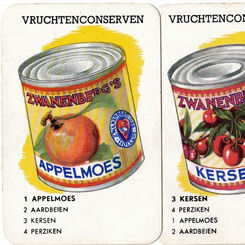
Zwanenberg’s Kwartetspel
Zwanenberg’s Kwartetspel printed by Speelkaartenfabriek Nederland, 1938.

Havermout Kwartetspel
“H-O Kwartetspel” children’s card game promoting quick cooking oatmeal (instant porridge), 1930s.
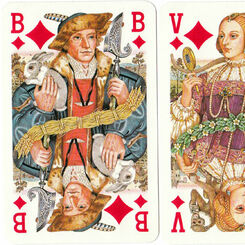
Nationale-Nederlanden
Playing cards produced for Nationale-Nederlanden insurance company, 1984.
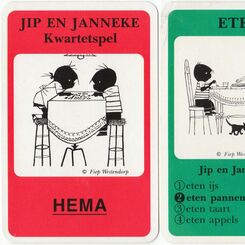
Jip en Janneke
Jip en Janneke quartet game published by Hema, a Dutch department store, c.1960.
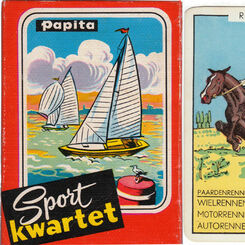
Papita Sport Kwartet
Papita Sport Kwartet by Nederlandse Spellenfabriek, c.1975.
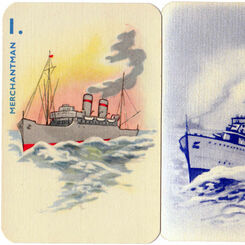
Convoy
“Convoy” WW2 card game published by Tree Brand c.1940, based on wartime naval convoys.
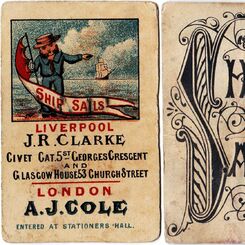
Ship Sails
“Ship Sails” card game c.1885.
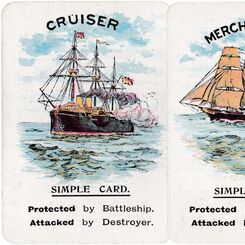
Sefite card game
“Sefite” card game, Woolley & Co,. Ltd, London, c.1905
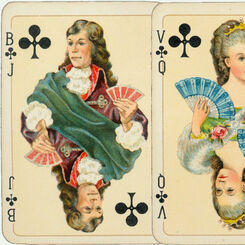
Royal Dutch Mail
Elegant “Nieuw Neerlandia” pattern designed by M.A. Koekkoek and produced by Speelkaartenfabriek Ned...
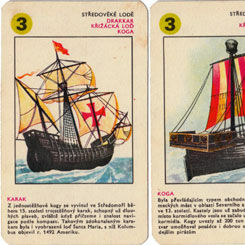
Historic Ships
“Historic Ships” quartet game from Czechoslovakia illustrated by Jaromír Vraštil.

Öbergs ‘Svenska Lloyd’
‘Svenska Lloyd’ shipping company playing cards published by J.O. Öberg & Son, Eskilstuna, c.1955.
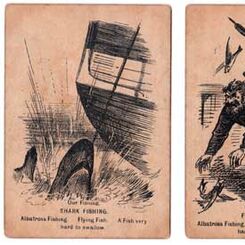
Our Ship
The “New Game of Our Ship”, published by Chas Goodall & Son, London, 1896.
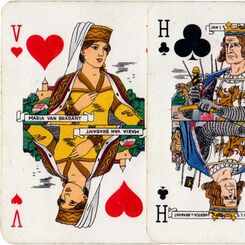
Noord Braband
“Historical Playing Cards” originally commissioned by Northern Brabant Insurance Society and manufac...
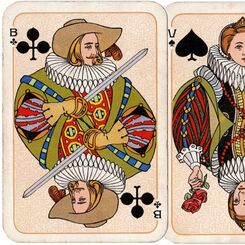
Nederlandse Speelkaarten Fabriek
Shipping line playing cards produced by Nederlandse Speelkaarten Fabriek, c.1910 offering a virtual ...

Speelkaarten-Fabriek Nederland “Fortuna”
Speelkaarten-Fabriek Nederland for Royal West Indian Mail Service, c.1926
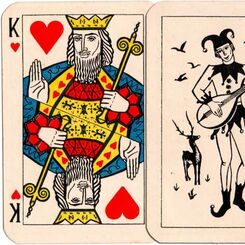
Anonymous Dutch deck, 1940s
Anonymous Dutch deck, 1940s
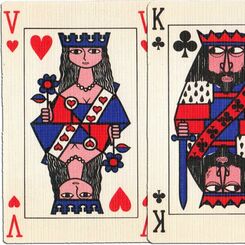
De Kloof
Advertising Playing Cards printed by Drukkerij Juten, published by “De Kloof” of Bergen op Zoom, Hol...
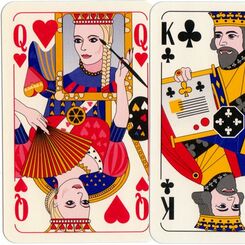
Esveco Specialities B.V.
Alto Imaging Group playing cards manufactured by Esveco Specialities B.V., c.1990s
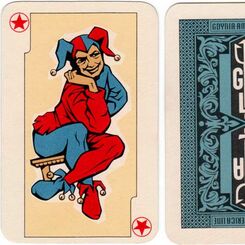
Gdynia-America Line
Non-standard playing cards produced by Artex (Budapest) for the Gdynia-America Line, Poland, c.1958....
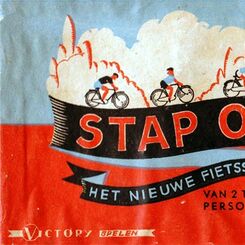
Stap Op
Stap Op by Penco for Victory Spelen 1945. A clone of Parker’s Touring except the Dutch have to do it...
Most Popular
Our top articles from the past 60 days



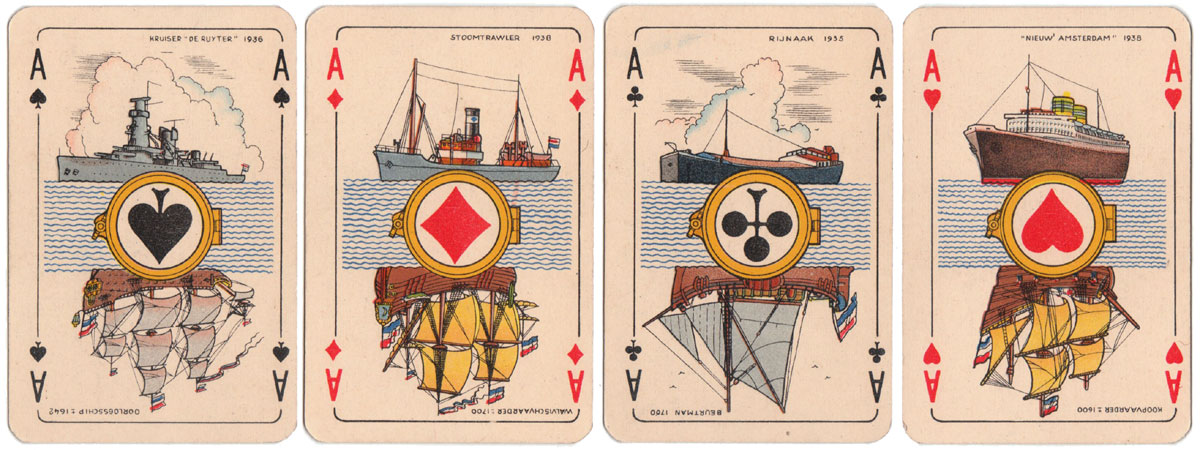
 Your comment here. Your comment here. Your comment here. Your comment here. Your comment here. Your comment here. Your comment here. Your comment here. Your comment here. Your comment here. Your comment here. Your comment here. Your comment here. Your comment here. Your comment here. Your comment here. Your comment here. Your comment here. Your comment here. Your comment here. Your comment here. Your comment here. Your comment here. Your comment here. Your comment here. Your comment here. Your comment here. Your comment here. Your comment here. Your comment here. Your comment here. Your comment here.
Your comment here. Your comment here. Your comment here. Your comment here. Your comment here. Your comment here. Your comment here. Your comment here. Your comment here. Your comment here. Your comment here. Your comment here. Your comment here. Your comment here. Your comment here. Your comment here. Your comment here. Your comment here. Your comment here. Your comment here. Your comment here. Your comment here. Your comment here. Your comment here. Your comment here. Your comment here. Your comment here. Your comment here. Your comment here. Your comment here. Your comment here. Your comment here.




















